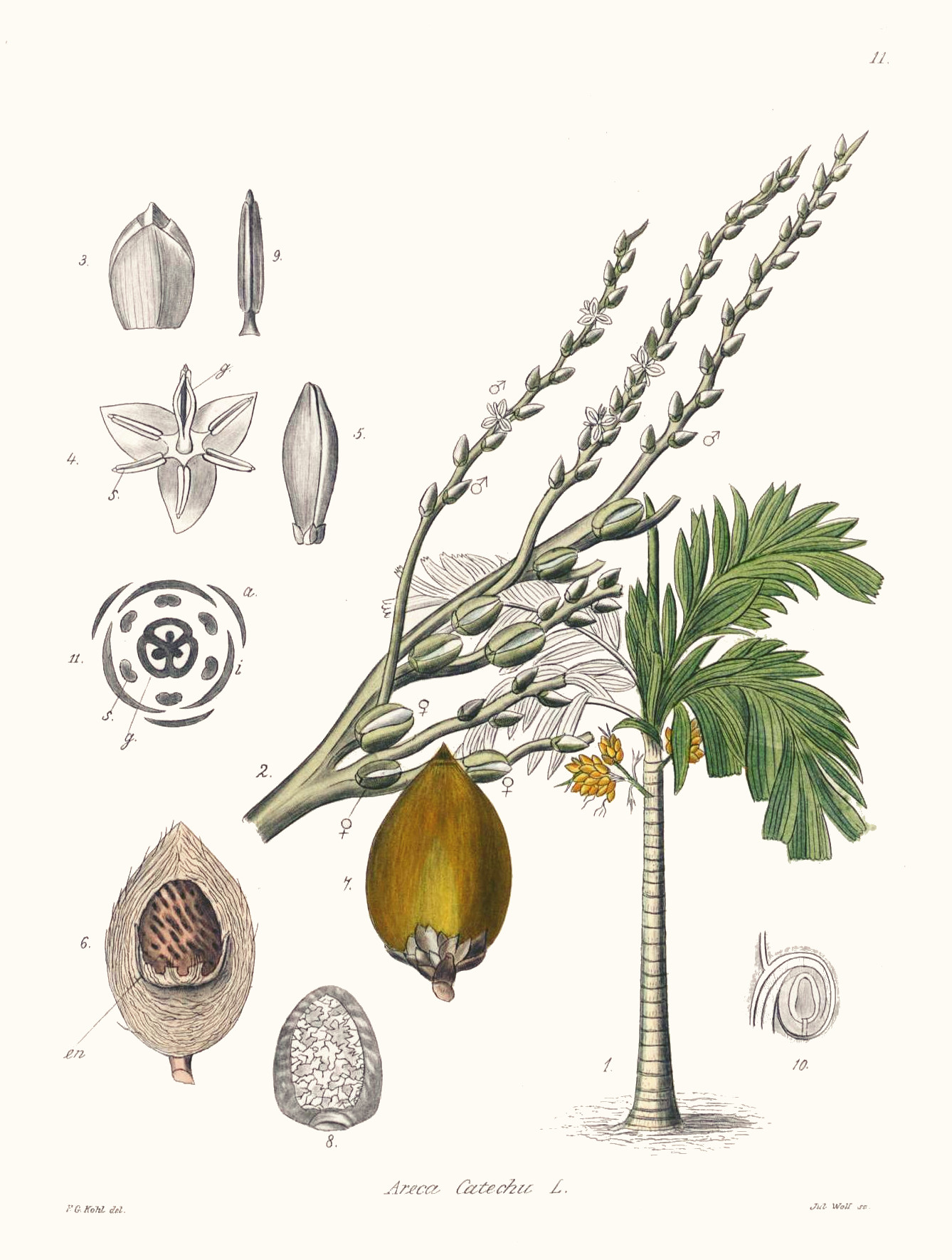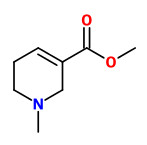Dies ist eine alte Version des Dokuments!
Arecaceae - betel palm, areca palm, Betelnusspalme, Arecapalme, Betelpalme, Katechupalme
Typical palm with smooth grey trunk, up to 30m high; native to Southeast Asia (Malay Peninsula); bunch of compound leaves at the top; leaves finely pinnate, 3-4m long; paniculate inflorescences in the axils of the leaves; flowers small and inconspicuous, the larger female flowers at the base of the panicle, the smaller male above them; fruits oval , turning orange with maturity, each with a single seed covered by a layer of husk.
„Flowering begins at 4-6 years of age; trees begin to bear at 7-8 years, reach full bearing at 10-15 years, continue to yield until ca. 40 years, then persist in a sterile state until death. The first inflorescences may contain only male flowers and consequently do not produce nuts. A mature tree in full bearing can have inflorescences containing up to 644 female and 15-48,000 male flowers (Murthy 1977). The male flowers open first. Their sweet scent attracts honeybees and other insects, but these insects do not frequent the female flowers and thus their role as pollinators is doubtful. Several days after the last male flower is shed, the female flowers open. They are fertilized by pollen that is wind-transported from neighboring trees.“ http://www.clshade.net/agroforestry/tti/Areca-catechu-betel-nut.pdf
„…many lemon yellow flowers emitting this scent marker of Tekadu [in Papua New Guinea]. In chemical and olfactory terms, this scent is mainly based on methyl benzoate, methyl salicylate and its methylated product, comparatively high levels of lavandulol and ist acetate, geraniol, 2-phenylethyl alcohol and its acetate, and β-ionone.“
[Roman Kaiser, Meaningful scents around the world, pp.80 and 216]
Areca catechu seeds, areca nut, Semen Arecae, Arecae semen, Betelnuss [JP XII, CRC]
Definition. Areca nuts are the fresh seeds from the Betel-nut palm, Areca catechu. The very hard brown nuts are flattened spherical or nearly spherical, up to 3cm in diameter. The taste is astringent and slightly bitter.
Constituents. Alkaloids, including 0.3-0.6% arecoline; tannins (15-18%), fat (14-18%) and carbohydrates.
Uses. Areca seed is used for centuries as mild psychostimulant, but also as digestive aid and vermifuge. The typical betel quid is regularly chewed by many (appr. 200 million, 1998) peoples of Southeast Asia. A betel quid is formed by wrapping slices of the Areca seed together with lime (calcium hydroxide), cinnamon and other spices, in a leaf of betel pepper (Piper betle L.). Betel chewing is often a social affair, for instance following a meal. Nut decoctions are used as anthelminthic, especially to remove tapeworms.
Side effects. The coloring matter present in the seeds turns the saliva bright red. Excessive use for years may stain the teeth red-brown to nearly black. Salivation and inappetence occur. Betel use is associated with oral leukoplakia, submucous fibrosis, and squamous cell carcinoma. [Norton SA, J. Am. Acad. Dermatol., 38(1), (1998), 81-88]
An association between betel-nut chewing and bronchoconstriction in asthmatic patients was established. [Taylor RF, al-Jarad N, John LM, Conroy DM, Barnes NC, Lancet, 339(8802), (1992), 1134-6]
Toxicity. Large doses (10g seeds or more) may lead to respiratory or cardial failure. Atropine is suggested as antidot. [Hager, CRC]

Kohl, F.G., Die officinellen Pflanzen der Pharmacopoea Germanica, t.11 (1891-1895)
http://plantgenera.org/species.php?id_species=82749

